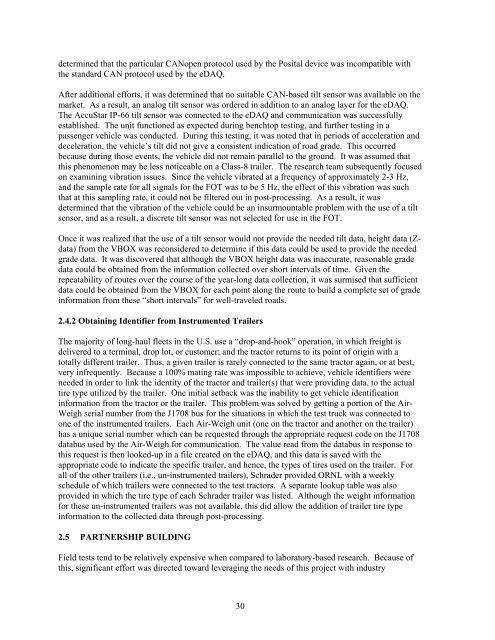Class-8 Heavy Truck Duty Cycle Project Final Report - Center for ...
Class-8 Heavy Truck Duty Cycle Project Final Report - Center for ...
Class-8 Heavy Truck Duty Cycle Project Final Report - Center for ...
Create successful ePaper yourself
Turn your PDF publications into a flip-book with our unique Google optimized e-Paper software.
determined that the particular CANopen protocol used by the Posital device was incompatible with<br />
the standard CAN protocol used by the eDAQ.<br />
After additional ef<strong>for</strong>ts, it was determined that no suitable CAN-based tilt sensor was available on the<br />
market. As a result, an analog tilt sensor was ordered in addition to an analog layer <strong>for</strong> the eDAQ.<br />
The AccuStar IP-66 tilt sensor was connected to the eDAQ and communication was successfully<br />
established. The unit functioned as expected during benchtop testing, and further testing in a<br />
passenger vehicle was conducted. During this testing, it was noted that in periods of acceleration and<br />
deceleration, the vehicle’s tilt did not give a consistent indication of road grade. This occurred<br />
because during those events, the vehicle did not remain parallel to the ground. It was assumed that<br />
this phenomenon may be less noticeable on a <strong>Class</strong>-8 trailer. The research team subsequently focused<br />
on examining vibration issues. Since the vehicle vibrated at a frequency of approximately 2-3 Hz,<br />
and the sample rate <strong>for</strong> all signals <strong>for</strong> the FOT was to be 5 Hz, the effect of this vibration was such<br />
that at this sampling rate, it could not be filtered out in post-processing. As a result, it was<br />
determined that the vibration of the vehicle could be an insurmountable problem with the use of a tilt<br />
sensor, and as a result, a discrete tilt sensor was not selected <strong>for</strong> use in the FOT.<br />
Once it was realized that the use of a tilt sensor would not provide the needed tilt data, height data (Zdata)<br />
from the VBOX was reconsidered to determine if this data could be used to provide the needed<br />
grade data. It was discovered that although the VBOX height data was inaccurate, reasonable grade<br />
data could be obtained from the in<strong>for</strong>mation collected over short intervals of time. Given the<br />
repeatability of routes over the course of the year-long data collection, it was surmised that sufficient<br />
data could be obtained from the VBOX <strong>for</strong> each point along the route to build a complete set of grade<br />
in<strong>for</strong>mation from these “short intervals” <strong>for</strong> well-traveled roads.<br />
2.4.2 Obtaining Identifier from Instrumented Trailers<br />
The majority of long-haul fleets in the U.S. use a “drop-and-hook” operation, in which freight is<br />
delivered to a terminal, drop lot, or customer; and the tractor returns to its point of origin with a<br />
totally different trailer. Thus, a given trailer is rarely connected to the same tractor again, or at best,<br />
very infrequently. Because a 100% mating rate was impossible to achieve, vehicle identifiers were<br />
needed in order to link the identity of the tractor and trailer(s) that were providing data, to the actual<br />
tire type utilized by the trailer. One initial setback was the inability to get vehicle identification<br />
in<strong>for</strong>mation from the tractor or the trailer. This problem was solved by getting a portion of the Air-<br />
Weigh serial number from the J1708 bus <strong>for</strong> the situations in which the test truck was connected to<br />
one of the instrumented trailers. Each Air-Weigh unit (one on the tractor and another on the trailer)<br />
has a unique serial number which can be requested through the appropriate request code on the J1708<br />
databus used by the Air-Weigh <strong>for</strong> communication. The value read from the databus in response to<br />
this request is then looked-up in a file created on the eDAQ, and this data is saved with the<br />
appropriate code to indicate the specific trailer, and hence, the types of tires used on the trailer. For<br />
all of the other trailers (i.e., un-instrumented trailers), Schrader provided ORNL with a weekly<br />
schedule of which trailers were connected to the test tractors. A separate lookup table was also<br />
provided in which the tire type of each Schrader trailer was listed. Although the weight in<strong>for</strong>mation<br />
<strong>for</strong> these un-instrumented trailers was not available, this did allow the addition of trailer tire type<br />
in<strong>for</strong>mation to the collected data through post-processing.<br />
2.5 PARTNERSHIP BUILDING<br />
Field tests tend to be relatively expensive when compared to laboratory-based research. Because of<br />
this, significant ef<strong>for</strong>t was directed toward leveraging the needs of this project with industry<br />
30
















